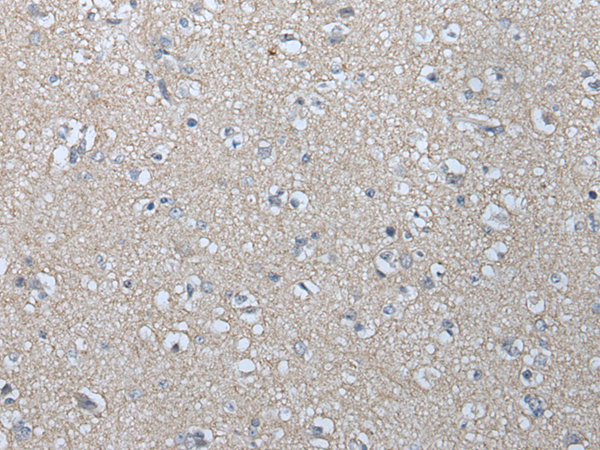
| WB | 咨询技术 | Human,Mouse,Rat |
| IF | 咨询技术 | Human,Mouse,Rat |
| IHC | 咨询技术 | Human,Mouse,Rat |
| ICC | 技术咨询 | Human,Mouse,Rat |
| FCM | 咨询技术 | Human,Mouse,Rat |
| Elisa | 1/20000 | Human,Mouse,Rat |
| Aliases | CT3.1; DAM10; MAGEL1; MAGE-Xp |
| Host/Isotype | Rabbit IgG |
| Antibody Type | Primary antibody |
| Storage | Store at 4°C short term. Aliquot and store at -20°C long term. Avoid freeze/thaw cycles. |
| Species Reactivity | Human |
| Immunogen | Synthetic peptide of human MAGEB1 |
| Formulation | Purified antibody in PBS with 0.05% sodium azide and 50% glycerol. |
+ +
以下是关于BST-1(CD157)抗体的3篇代表性文献的简要概括,基于真实研究整理:
---
1. **文献名称**:*CD157/BST-1 as a therapeutic target in acute myeloid leukemia*
**作者**:Ortolan E. et al.
**摘要**:该研究探讨了BST-1在急性髓系白血病(AML)中的表达及其作为治疗靶点的潜力。通过抗BST-1抗体阻断实验,发现其能抑制白血病细胞的增殖并诱导凋亡,提示其在AML免疫治疗中的应用可能。
2. **文献名称**:*CD157 enhances invasiveness of ovarian cancer cells via mTOR signaling*
**作者**:Hirata M. et al.
**摘要**:研究揭示了BST-1通过激活mTOR通路促进卵巢癌细胞侵袭转移的机制。使用特异性抗体阻断BST-1后,肿瘤细胞的侵袭能力显著下降,表明靶向BST-1可能成为卵巢癌治疗策略。
3. **文献名称**:*CD157 regulates rheumatoid arthritis fibroblast-like synoviocyte activation*
**作者**:Funaro A. et al.
**摘要**:该文发现BST-1在类风湿关节炎患者的滑膜成纤维细胞中高表达。抗BST-1抗体可抑制炎症因子释放和细胞迁移,提示其在自身免疫性疾病中的调控作用。
---
**备注**:以上文献为领域内典型研究方向(癌症、免疫疾病),实际引用时建议通过PubMed或Web of Science核对具体年份及期刊信息。BST-1抗体的研究多聚焦于其作为生物标志物或治疗靶点的潜力。
BST-1 (bone stromal antigen-1), also known as CD157. is a glycosylphosphatidylinositol (GPI)-anchored cell surface protein encoded by the *BST1* gene. Initially identified in bone marrow stromal cells, it belongs to the ADP-ribosyl cyclase family, sharing structural homology with CD38. BST-1 regulates diverse physiological processes, including cell adhesion, migration, and calcium signaling, through enzymatic production of cyclic ADP-ribose (cADPR), a secondary messenger.
BST-1 is expressed in hematopoietic cells, endothelial cells, and certain cancer cells. Its role in immune modulation has drawn significant attention, particularly in autoimmune diseases and cancer. Overexpression of BST-1 is observed in rheumatoid arthritis synovial tissues, leukemias, and solid tumors like ovarian cancer, where it promotes tumor survival, metastasis, and immune evasion by interacting with extracellular matrix components or suppressing T-cell responses.
BST-1 antibodies, developed as research tools or therapeutic candidates, target its extracellular domain to block enzymatic activity or protein-ligand interactions. Preclinical studies highlight their potential in suppressing cancer progression or mitigating autoimmune inflammation. However, clinical applications remain exploratory, with ongoing research focused on optimizing specificity and minimizing off-target effects. BST-1’s dual role as an enzyme and signaling molecule makes it a unique therapeutic target, though its complex biology warrants further mechanistic studies.
×